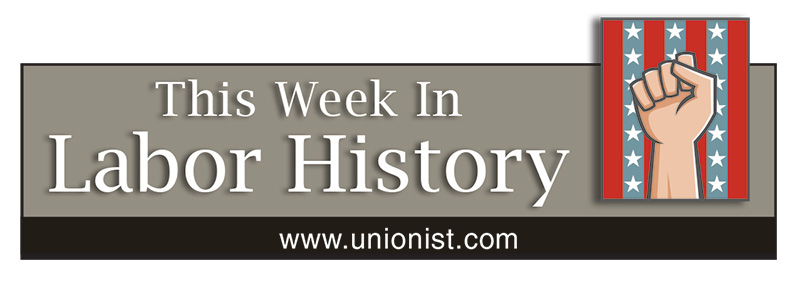This week in labor history: March 22-28

MARCH 22
1886 – Mark Twain, a lifelong member of the Int’l Typographical Union (now part of CWA), speaks in Hartford, Conn., extolling the Knights of Labor’s commitment to fair treatment of all workers, regardless of race or gender.
1941 – The Grand Coulee Dam on Washington state’s Columbia River begins operation after a decade of construction. Eight thousand workers labored on the project; 77 died.
1982 – Eight hundred striking workers at Brown & Sharpe in Kingstown, R.I. are tear-gassed by state and local police in what was to become a losing 17-year-long fight by the Machinists union.
1990 – A 32-day lockout of major league baseball players ends with an agreement to raise the minimum league salary from $68,000 to $100,000 and to study revenue-sharing between owners and players.
1998 – A bitter six-and-a-half-year UAW strike at Caterpillar Inc. ends. The strike and settlement, which included a two-tier wage system and other concessions, deeply divided the union.
MARCH 23
1918 – Trial of 101 Wobblies, charged with opposing the draft and hindering the war effort, begins in Chicago.
1932 – Norris-La Guardia Act restricts injunctions against unions and bans yellow dog contracts, which require newly-hired workers to declare they are not union members and will not join one.
1970 – Five days into the Post Office’s first mass work stoppage in 195 years, President Nixon declares a national emergency and orders 30,000 troops to New York City to break the strike. The troops didn’t have a clue how to sort and deliver mail: a settlement came a few days later.
1974 – Coalition of Labor Union Women (CLUW) founded in Chicago by some 3,000 delegates from 58 unions and other organizations.
2005 – Fifteen workers die, another 170 are injured when a series of explosions rip through BP’s Texas City refinery. Investigators blamed a poor safety culture at the plant and found BP management gave priority to cost savings over worker safety.
MARCH 24
1900 – Groundbreaking on the first section of the New York City subway system, from City Hall to the Bronx. According to the New York Times, this was a worker’s review of the digging style of the well-dressed Subway Commissioners: “I wouldn’t give th’ Commish’ners foive cents a day fer a digging job. They’re too shtiff.”
MARCH 25
1872 – Toronto printers strike for the nine-hour day in what is believed to be Canada’s first major strike.
1894 – First “Poor People’s March” on Washington, in which jobless workers demanded creation of a public works program. Led by populist Jacob Coxey, the 500 to 1,000 unemployed protesters became known as “Coxey’s Army.”
1911 – A total of 146 workers are killed in a fire at New York’s Triangle Shirtwaist Factory, a disaster that would launch a national movement for safer working conditions.
1947 – An explosion at a coal mine in Centralia, Ill., kills 111 miners. Mineworkers President John L. Lewis calls a six-day work stoppage by the nation’s 400,000 soft coal miners to demand safer working conditions.
MARCH 26
1868 – San Francisco brewery workers begin a nine-month strike as local employers follow the union-busting lead of the National Brewer’s Association and fire their unionized workers, replacing them with scabs. Two unionized brewers refused to go along, kept producing beer, prospered wildly and induced the Association to capitulate. A contract benefit since having unionized two years earlier, certainly worth defending: free beer.
MARCH 27
1904 – Mother Jones is ordered to leave Colorado, where state authorities accuse her of “stirring up” striking coal miners.
2002 – U.S. Supreme Court rules that undocumented workers do not have the same rights as Americans when they are wrongly fired.
MARCH 28
1935 – Members of Gas House Workers’ Union Local 18799 begin what is to become a four-month recognition strike against the Laclede Gas Light Co. in St. Louis. The union later said the strike was the first ever against a public utility in the U.S.
1968 – Martin Luther King, Jr., leads a march of striking sanitation workers, members of AFSCME Local 1733, in Memphis, Tenn. Violence during the march persuades him to return the following week to Memphis, where he was assassinated.
(Compiled by David Prosten, founder of Union Communication Services)


Leave a Reply